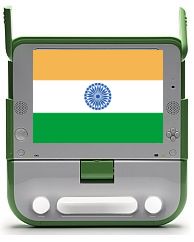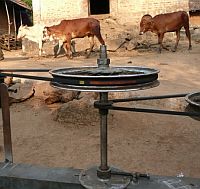
A year ago, One Laptop Per Child was lambasted by India's Education Secretary Sudeep Banerjee who called Nicholas Negroponte's idea of Constructionist learning through XO laptops "pedagogically suspect."
Now I suspect that a portion of that rejection was due to the MIT India backstory and India's own laptop fantasies. But not matter the reason, India has been a sore spot for OLPC. As Nicholas Negroponte says:
India has more child population than any other country and will benefit greatly from a creative society of them. India needs to take a role of world leadership in the concept of one laptop per child, even if it is ahead of its time and seemingly daunting.And yet it has a massive education problem. A problem that OLPC now hopes to solve using an alliance with Reliance Anil Dhirubhai Ambani Group (R-ADAG) to provide logistics to the OLPC's India initiative:
Currently, the first pilot of the XO laptop is supposed to be in tribal village at Khairat (near Karjat, Maharashtra). By March 2008, OLPC Foundation with the Reliance network aims to cover over 25,000 towns and 60,000 villages.Now that sounds really impressive, eh? Like OLPC India is going to be a massive educational movement. A One Laptop Per Indian Child on the magnitude of millions that Negroponte has always dreamed of. Well, take a closer look at that dream, like Brian Bergstein has:Sumit Chowdhury, CIO, RCOM, stated, “We will facilitate this system by getting all the players together like Government agencies, NGOs, content developers, translators, teaching community and project managers to create successful ecosystems.
We plan to approach state governments who have an education agenda and see if any public-private partnership can be worked out for the mass adoption of these laptops.”
A pilot test began recently in which 22 children in first through fourth grades in a rural, one-room school in the Indian state of Maharashtra are using the computers.Wait, OLPC India is starting with only twenty-two laptops? You mean like just one classroom of children in one rural school? In a country of 1.something Billion? I know I was hoping for OLPC to start local, small even, when I wrote about OLPC Mongolia but not 22 XO laptops small.Carla Gomez-Monroy, the education consultant who launched the test, said One Laptop Per Child has learned that working with local partners will be crucial in India, where dozens of languages are spoken.
But I guess they have to start somewhere and 22 is greater than zero. Too bad it will only confirm Atanu Dey's Rube Goldberg thoughts about One Laptop Per Child and disappoint the hopeful OLPC India listserv.



Considering that India was talking about building their own XO competitor for 50 dollars a machine I think any pilot is a very good thing, since the Indian competitor is still vaporware and the XO has 22 new users wondering what the 22 different LANG variable settngs are going to be.
Ned
Wayan, I need that picture of cows and belts. May I?
Kind regards,
Atanu
Atanu,
The cow power image is from the OLPC India mailing list & already republished on several different sites. Feel free to use it as you would any other. I do not have any special ownership of it except being the accidental starter of the interest in the image from a comment I made to the press celebrating it as an ingenious solution to the power problem.
OLPC India should have more local languages available for this pilot:
Sumit Chowdhury reports that Nandu Pradhan, president of RedHat India, is working with a team next week to help provide localization support in eleven Indian languages. Sarmad Hussein of the PAN Localization project and the CRULP research center has offered help with Pashto, Urdu, and Nepali keyboards and localization. http://lists.laptop.org/pipermail/community-news/2007-October/000082.html
I think India and developing countries are going at olpc all wrong. A great many school-age children in these countries receive little or no education. The standard proposed solution is for the countries to spend more money on education. But they don't have the money to provide teachers, classrooms, and books for all their students, much less adding in more cost for laptops.
These countries are poor, so the question is how to get a large educational impact for a small amount of money. The solution is to load up each laptop with self-instructional programs in reading, writing, mathematics, and other basic subjects. And then give one laptop to the parents of each family, with the explanation that they are to have their children use it for educational purposes (and of course the parents could also use it themselves for education). The focus would be on groups that are at present getting a minimal amount of public education
Now figure that in a few years olpc will cost only $50. Now let's add in distribution, support, and corruption, and run it up to $150 (note I am leaving out internet connection, as it is not necessary for this model). And suppose only two children in a typical family actually use it for educational purposes, and each does so 2 hours a day, five days a week. And assume the laptop lasts three years before it breaks. Do the math. For 150 dollars you will be getting 3000 hours of computer self-instruction. That's five cents an hour. Put another way, it's $25 per student per year.
Now compare that with the standard model of classrooms, books, and teachers. I don't know the figures, but I sure that even in developing countries the cost is far more.
The problem with this model is not that it wouldn't work. It is that it is contrary to accepted ways of doing things, and also contrary to certain vested political interests, It is, however, a far better way to go about improving education in the developing world than any of the standard solutions.
I see I didn't make clear that the children in the families that received the laptops could use them at home, including children who don't go to school at all.
Just what we need to do, make more foreign people computer literate. Then they can take more jobs away from American workers, then return at night to their huts and squalor.
I think India and developing countries are going at olpc all wrong. A great many school-age children in these countries receive little or no education. The standard proposed solution is for the countries to spend more money on education. But they don't have the money to provide teachers, classrooms, and books for all their students, much less adding in more cost for laptops.
Wayan, click on shashi singh's name and you go to a commercial site. I think the post was generated by a script.
Eduardo,
While I don't think it was a script, I've deleted the link just to be safe.
Sudeep Banerjee is right that if India had the money to distribute a laptop to every kid, then this money could have been spent better on secondary education.
Buying this OLPC laptop for every kid is similar to buying gold plated wheels for a cart, as far as India is concerned.
i am living in delhi in INDIA and want this xo laptop how can i get
please help me in contacting olpc
In India, the problem is not so much the money, the problem is corruption and inefficiency. The government schools are simply NOT working. Teachers come to teach when they want and most of the students are not learning anything. They don't reach the end of primary, specially girls. The Cast system and The dowry system are making the situation even more difficult. The worst situation is in the villages because nobody cares about villagers. My opinion is that OLPC foundation should work with NGOs in India, NOT with central or local governments.
Wayan Vota
I am Rajiv Pathak. we are an NGO working in South Gujarat. we are teaching IT/English in south Gujarat's Valsad district. We are using actual laptops in teaching them IT and English.
I want to visit khairat for better understanding of your model. Can you give me any contact numbers of Khairat school or it's teachers.
My mail address is Rajiv.pathak@maafoundation.org
Please pass on the details so that i can visit Khairat.
In India, the problem is not so much the money, the problem is corruption and inefficiency. The government schools are simply NOT working. Teachers come to teach when they want and most of the students are not learning anything.